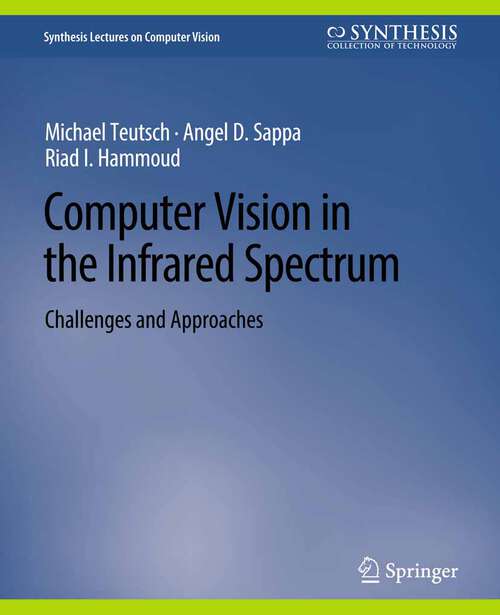Computer Vision in the Infrared Spectrum: Challenges and Approaches (Synthesis Lectures on Computer Vision)
By: and and
Sign Up Now!
Already a Member? Log In
You must be logged into UK education collection to access this title.
Learn about membership options,
or view our freely available titles.
- Synopsis
- Human visual perception is limited to the visual-optical spectrum. Machine vision is not. Cameras sensitive to the different infrared spectra can enhance the abilities of autonomous systems and visually perceive the environment in a holistic way. Relevant scene content can be made visible especially in situations, where sensors of other modalities face issues like a visual-optical camera that needs a source of illumination. As a consequence, not only human mistakes can be avoided by increasing the level of automation, but also machine-induced errors can be reduced that, for example, could make a self-driving car crash into a pedestrian under difficult illumination conditions. Furthermore, multi-spectral sensor systems with infrared imagery as one modality are a rich source of information and can provably increase the robustness of many autonomous systems. Applications that can benefit from utilizing infrared imagery range from robotics to automotive and from biometrics to surveillance. In this book, we provide a brief yet concise introduction to the current state-of-the-art of computer vision and machine learning in the infrared spectrum. Based on various popular computer vision tasks such as image enhancement, object detection, or object tracking, we first motivate each task starting from established literature in the visual-optical spectrum. Then, we discuss the differences between processing images and videos in the visual-optical spectrum and the various infrared spectra. An overview of the current literature is provided together with an outlook for each task. Furthermore, available and annotated public datasets and common evaluation methods and metrics are presented. In a separate chapter, popular applications that can greatly benefit from the use of infrared imagery as a data source are presented and discussed. Among them are automatic target recognition, video surveillance, or biometrics including face recognition. Finally, we conclude with recommendations for well-fitting sensor setups and data processing algorithms for certain computer vision tasks. We address this book to prospective researchers and engineers new to the field but also to anyone who wants to get introduced to the challenges and the approaches of computer vision using infrared images or videos. Readers will be able to start their work directly after reading the book supported by a highly comprehensive backlog of recent and relevant literature as well as related infrared datasets including existing evaluation frameworks. Together with consistently decreasing costs for infrared cameras, new fields of application appear and make computer vision in the infrared spectrum a great opportunity to face nowadays scientific and engineering challenges.
- Copyright:
- 2022
Book Details
- Book Quality:
- Publisher Quality
- ISBN-13:
- 9783031018268
- Related ISBNs:
- 9783031000836
- Publisher:
- Springer International Publishing
- Date of Addition:
- 06/01/22
- Copyrighted By:
- N/A
- Adult content:
- No
- Language:
- English
- Has Image Descriptions:
- No
- Categories:
- Nonfiction, Art and Architecture, Computers and Internet
- Submitted By:
- Bookshare Staff
- Usage Restrictions:
- This is a copyrighted book.
Reviews
Other Books
- by Michael Teutsch
- by Angel D. Sappa
- by Riad I. Hammoud
- in Nonfiction
- in Art and Architecture
- in Computers and Internet
